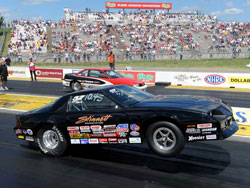Strong Super Stock Final Round Appearance for Gary Stinnett During NHRA Topeka Event
- Jun 6, 2012
"I put a legal Super Stock motor in this car over the winter and then took it to the NHRA divisional at Great Bend [SRCA Dragstrip] to kind of sort it out," Stinnett said. "Next we took it to Topeka to race it and everything went smoothly. Early in the weekend, the thing was too violent on the launch and it was just coming up way too high. So round by round, I just kept putting five or ten more pounds on the front of the car and kept dialing accordingly for the additional weight. By the time we got to Sunday, the weather was so much better that I ended up having to put another fifteen pounds on the front of it and in the final, it actually got too high again on launch." The Super Stock categories are known and loved for their side-by-side crowd pleasing wheel stands and while the fans may enjoy the wheels hanging in the air as the cars blast past the Christmas Tree, there are actually other reasons the wheel stands are a good thing, besides their aesthetically pleasing wow factor. "You need it to come up and transfer the weight," noted Stinnett. "There is a fine line between a perfect run and it getting too high." Folks who don't compete in the Stock or Super Stock ranks may not know that many times a car can be built for one class and with a little weight change here and there, can easily slip into another. For Stinnett and his 1990 Camaro, he decided to change classes after seeing some of the other cars that were entered for the event. "The car is actually an 'H' car [GT/HA classification]," he said. "But because David Rampy and Jeff Town were both going to run in 'H,' I ran it in 'G.' So I was actually a couple of hundred pounds heavy and it looked like at the beginning of the race that making that class change was going to be a mistake because Lloyd Wofford showed up in 'G' and he was number one qualifier. We had class at this event and when I ran him, he outran me by five tenths, of course two of those tenths is because I was two hundred pounds overweight, but there was no way I could take it out." With qualifying for the main event completed and this now in the back of Stinnett's mind, he's carefully looking ahead at the ladder and the potential match up with Wofford in round four. "Fortunately for me, Lloyd went out in round three or I would have never made it to the final, since we would have had a GT/GA heads up match," he confessed. "At the beginning of the weekend, it wasn't looking very good for me when I saw that we may have to meet up and there was no way I would have been able to beat him. With Lloyd going out, I then had to run Jeff Town and not have to worry about a heads up, because I was in 'G' instead of 'H' like I would normally be."
"I had even tried to place myself on the ladder and try to avoid meeting up with Lloyd," he said. "I shut off on my first qualifying run, but with all the shuffling that was going on during class eliminations, it was really hard to try to pick your spot on the ladder." Prior to meeting up with Town in round four, Stinnett sent home Pete Peery, Kyle Ratliff and Jason DeForrest, who wanted the round win a little too much and turned it .008 red. Knowing the air on Sunday was much better than what the racers had been dealing with the two days prior and the wind had now changed directions, Stinnett dialed his K&N 1990 Camaro down a few numbers and set out to take on Town and his '87 Somerset. Stinnett held two full hundreds over Town as the two past the tree and used it to force the fellow Kansas racer under the dial. Next he would move on to the semi-finals to face Korey Mawhee. Again with the starting line advantage, Stinnett masterfully drove his Camaro to a 10.459 on his 10.45 dial to defeat Mawhee's 9.604 on his 9.59 dial and move on to the Super Stock final to take on Eric Pearson in his very first NHRA national event final round appearance. "As I mentioned earlier, the car was still getting too high in the front on the launch. When a car gets that high [wheelstand], it literally runs out of gas at a forty-five degree angle," he explained. "And in the final, it actually stumbled just a little bit on me. Plus when I got to the finish line, I screwed it up by trying to be a hero and tightening it up too much and actually gave it back [stripe] by two thou." While the Super Stock title for this event may not have been in the cards for the multi-time NHRA World Champ, it's not really a class that he had set out to pursue a championship in for the 2012 season and looks to get back to his hope of a charge to the top in his beloved Super Comp class and his 1967 Camaro with which he will be competing in Super Street. "I really want to play around with the Super Street car and get it working the way I want it to," he said. "It was a Super Stock D/A car that I have put a 582ci in. It's pretty heavy and it weighs 3275, but the 582 makes a 1050 horsepower. So at Topeka, I have been running 10.90's at 148-149mph. I'm just trying to get it perfected, it really works pretty well but I want it to be perfected. For the last few years I have run Stock and Super Stock as my secondary category. Now I want that secondary category to be Super Street to compliment my Super Comp car. I've won NHRA national events in four different categories and I'll have three opportunities to make that five this year between Chicago, Denver and Dallas." When not blazing down a drag strip somewhere and turning on win lights, Stinnett is a well-known engine builder who puts together well over seventy power plants ranging in many different cubic inch combinations. Whether it's his racing engine or a customer, Stinnett insists on every motor having the protection of a K&N oil filter. "They are the absolute most elite filter manufacturer on the market," Stinnett pointed out. "No matter what it is, we try to use only the best in everything we do and everything we build. With K&N we know what we are getting each and every time. The protection of these high dollar motors should only be trusted to the best and that's K&N. For 2012, I also added the second generation K&N Dragster Composite scoop and just with that change, even picked up some mile-per-hour in my Super Comp Dragster." Find K&N products for your vehicle using the K&N application search then use the K&N dealer search to find a K&N dealer in your part of the world. |

![The car was still getting too high in the front on the launch. When a car gets that high [wheelstand], it literally runs out of gas at a forty-five degree angle.](https://www.knfilters.com/media/images/press/gary-stinnett14s.jpg)










